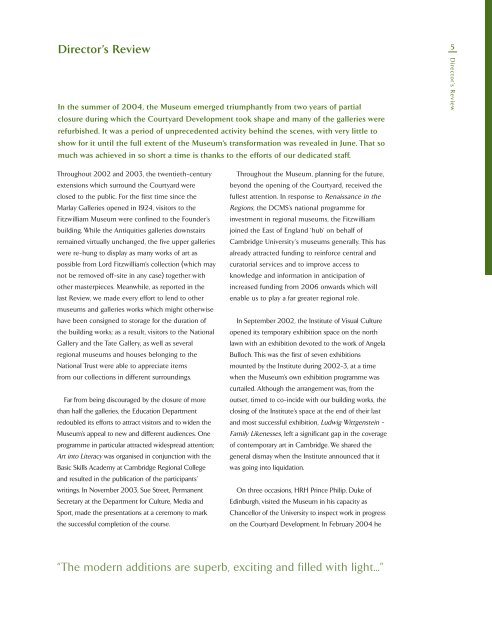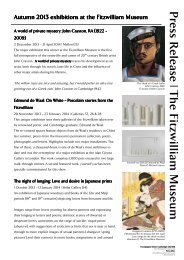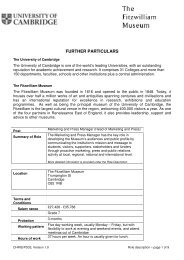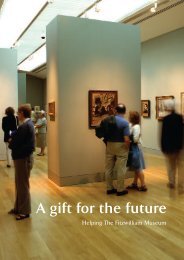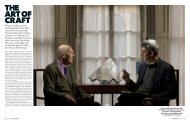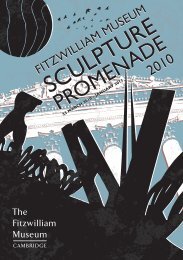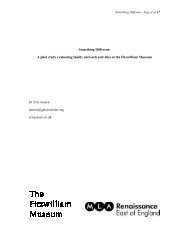The Fitzwilliam Museum - University of Cambridge
The Fitzwilliam Museum - University of Cambridge
The Fitzwilliam Museum - University of Cambridge
Create successful ePaper yourself
Turn your PDF publications into a flip-book with our unique Google optimized e-Paper software.
Director’s Review<br />
In the summer <strong>of</strong> 2004, the <strong>Museum</strong> emerged triumphantly from two years <strong>of</strong> partial<br />
closure during which the Courtyard Development took shape and many <strong>of</strong> the galleries were<br />
refurbished. It was a period <strong>of</strong> unprecedented activity behind the scenes, with very little to<br />
show for it until the full extent <strong>of</strong> the <strong>Museum</strong>‘s transformation was revealed in June. That so<br />
much was achieved in so short a time is thanks to the efforts <strong>of</strong> our dedicated staff.<br />
Throughout 2002 and 2003, the twentieth-century<br />
extensions which surround the Courtyard were<br />
closed to the public. For the first time since the<br />
Marlay Galleries opened in 1924, visitors to the<br />
<strong>Fitzwilliam</strong> <strong>Museum</strong> were confined to the Founder’s<br />
building. While the Antiquities galleries downstairs<br />
remained virtually unchanged, the five upper galleries<br />
were re-hung to display as many works <strong>of</strong> art as<br />
possible from Lord <strong>Fitzwilliam</strong>’s collection (which may<br />
not be removed <strong>of</strong>f-site in any case) together with<br />
other masterpieces. Meanwhile, as reported in the<br />
last Review, we made every effort to lend to other<br />
museums and galleries works which might otherwise<br />
have been consigned to storage for the duration <strong>of</strong><br />
the building works; as a result, visitors to the National<br />
Gallery and the Tate Gallery, as well as several<br />
regional museums and houses belonging to the<br />
National Trust were able to appreciate items<br />
from our collections in different surroundings.<br />
Far from being discouraged by the closure <strong>of</strong> more<br />
than half the galleries, the Education Department<br />
redoubled its efforts to attract visitors and to widen the<br />
<strong>Museum</strong>’s appeal to new and different audiences. One<br />
programme in particular attracted widespread attention;<br />
Art into Literacy was organised in conjunction with the<br />
Basic Skills Academy at <strong>Cambridge</strong> Regional College<br />
and resulted in the publication <strong>of</strong> the participants’<br />
writings. In November 2003, Sue Street, Permanent<br />
Secretary at the Department for Culture, Media and<br />
Sport, made the presentations at a ceremony to mark<br />
the successful completion <strong>of</strong> the course.<br />
Throughout the <strong>Museum</strong>, planning for the future,<br />
beyond the opening <strong>of</strong> the Courtyard, received the<br />
fullest attention. In response to Renaissance in the<br />
Regions, the DCMS’s national programme for<br />
investment in regional museums, the <strong>Fitzwilliam</strong><br />
joined the East <strong>of</strong> England ‘hub’ on behalf <strong>of</strong><br />
<strong>Cambridge</strong> <strong>University</strong>’s museums generally. This has<br />
already attracted funding to reinforce central and<br />
curatorial services and to improve access to<br />
knowledge and information in anticipation <strong>of</strong><br />
increased funding from 2006 onwards which will<br />
enable us to play a far greater regional role.<br />
In September 2002, the Institute <strong>of</strong> Visual Culture<br />
opened its temporary exhibition space on the north<br />
lawn with an exhibition devoted to the work <strong>of</strong> Angela<br />
Bulloch. This was the first <strong>of</strong> seven exhibitions<br />
mounted by the Institute during 2002-3, at a time<br />
when the <strong>Museum</strong>’s own exhibition programme was<br />
curtailed. Although the arrangement was, from the<br />
outset, timed to co-incide with our building works, the<br />
closing <strong>of</strong> the Institute’s space at the end <strong>of</strong> their last<br />
and most successful exhibition, Ludwig Wittgenstein -<br />
Family Likenesses, left a significant gap in the coverage<br />
<strong>of</strong> contemporary art in <strong>Cambridge</strong>. We shared the<br />
general dismay when the Institute announced that it<br />
was going into liquidation.<br />
On three occasions, HRH Prince Philip, Duke <strong>of</strong><br />
Edinburgh, visited the <strong>Museum</strong> in his capacity as<br />
Chancellor <strong>of</strong> the <strong>University</strong> to inspect work in progress<br />
on the Courtyard Development. In February 2004 he<br />
“<strong>The</strong> modern additions are superb, exciting and filled with light...”<br />
5<br />
Director’s Review


